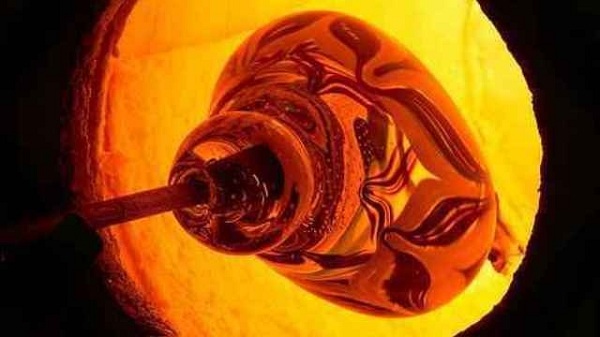Glass Melting Temperature: Exploring the Temperature Range for Glass Transformation
Glass is a fascinating material with various applications, ranging from windows and bottles to intricate artworks. One key aspect of glass is its melting temperature, which plays a crucial role in its formation and shaping. In this article, we will delve into the temperature at which glass melts, exploring different types of glass and their respective melting points. Join us as we uncover the science behind glass transformation.

Glass melt
I. Understanding Glass Melting:
Glass melting is the process of heating glass to a specific temperature at which it transforms from a solid state to a molten or liquid state. The melting temperature of glass depends on its composition and can vary for different types of glass. Let's examine some common types of glass and their respective melting points:
1. Soda-Lime Glass: Soda-lime glass is the most common type of glass used in windows, bottles, and household objects. It is composed of silica (sand), soda ash, and limestone. The melting temperature of soda-lime glass ranges from 1,000 to 1,500 degrees Celsius (1,832 to 2,732 degrees Fahrenheit).
2. Borosilicate Glass: Borosilicate glass is known for its high thermal resistance and is commonly used in laboratory glassware, cookware, and certain types of lighting. It contains silica and boron oxide. The melting temperature of borosilicate glass is approximately 1,400 to 1,600 degrees Celsius (2,552 to 2,912 degrees Fahrenheit).
3. Aluminosilicate Glass: Aluminosilicate glass is a type of glass that contains significant amounts of aluminum oxide (alumina) and silica. It exhibits high mechanical strength and resistance to thermal shock, making it suitable for applications such as smartphone screens and bulletproof glass. The melting temperature of aluminosilicate glass can range from 1,550 to 1,650 degrees Celsius (2,822 to 3,002 degrees Fahrenheit).
4. Quartz Glass: Quartz glass, also known as fused silica, is a high-purity form of glass primarily composed of silica. It has excellent optical properties and is used in scientific instruments, semiconductors, and high-temperature applications. Quartz glass has a melting temperature of around 1,600 to 1,750 degrees Celsius (2,912 to 3,182 degrees Fahrenheit).
Comparing Glass Melting Temperatures:
| Glass Type | Melting Temperature Range (°C) | Melting Temperature Range (°F) |
|---|---|---|
| Soda-Lime Glass | 1,000 - 1,500 | 1,832 - 2,732 |
| Borosilicate Glass | 1,400 - 1,600 | 2,552 - 2,912 |
| Aluminosilicate Glass | 1,550 - 1,650 | 2,822 - 3,002 |
| Quartz Glass | 1,600 - 1,750 | 2,912 - 3,182 |
It is important to note that these temperature ranges are approximate and can vary depending on the specific composition of the glass and the desired properties.

Glass melting on fire
II. Factors Affecting Glass Melting Temperature:
1. Composition: The composition of glass significantly influences its melting temperature. Glass primarily consists of silica (SiO2), but different types of glass incorporate various additives and modifiers. For example, soda-lime glass contains soda ash and limestone, while borosilicate glass incorporates boron oxide. These additives affect the intermolecular forces within the glass structure, altering its melting temperature.
2. Impurities: Impurities present in the glass composition can also impact its melting temperature. Common impurities include small amounts of metals, such as iron or chromium. These impurities can act as nucleation sites, affecting the stability and mobility of the glass structure, and consequently influencing the melting temperature.
3. Heat Treatment: The heat treatment processes that glass undergoes during manufacturing can affect its melting temperature. Annealing, tempering, or strengthening processes involve controlled heating and cooling, which can modify the glass's internal stresses and its resistance to thermal expansion. These processes can influence the glass's melting behavior.
4. Heating Rate: The rate at which glass is heated can affect its melting temperature. Rapid heating can result in devitrification, where the glass starts to crystallize instead of melting uniformly. Therefore, the heating rate needs to be carefully controlled to achieve a desired melting temperature.
III. Types of Glass and Their Melting Temperatures:
Here are some common types of glass and their respective melting temperatures:
1. Soda-Lime Glass: Soda-lime glass, widely used in windows, bottles, and household items, has a melting temperature range of approximately 1,000 to 1,500 degrees Celsius (1,832 to 2,732 degrees Fahrenheit).
2. Borosilicate Glass: Borosilicate glass, known for its high thermal resistance, is used in laboratory glassware and cookware. It has a higher melting temperature range of about 1,400 to 1,600 degrees Celsius (2,552 to 2,912 degrees Fahrenheit).
3. Quartz Glass: Quartz glass, also known as fused silica, has exceptional optical properties and is used in scientific instruments and high-temperature applications. It has a melting temperature range of approximately 1,600 to 1,750 degrees Celsius (2,912 to 3,182 degrees Fahrenheit).
Glass melting temperature is a critical factor in the production and shaping of glass. Different types of glass have varying melting points, with soda-lime glass typically melting between 1,000 and 1,500 degrees Celsius. Borosilicate glass, aluminosilicate glass, and quartz glass have higher melting temperatures. Understanding the melting temperature of glass is crucial for industries that work with glass and for individuals interested in the science behind this versatile material.